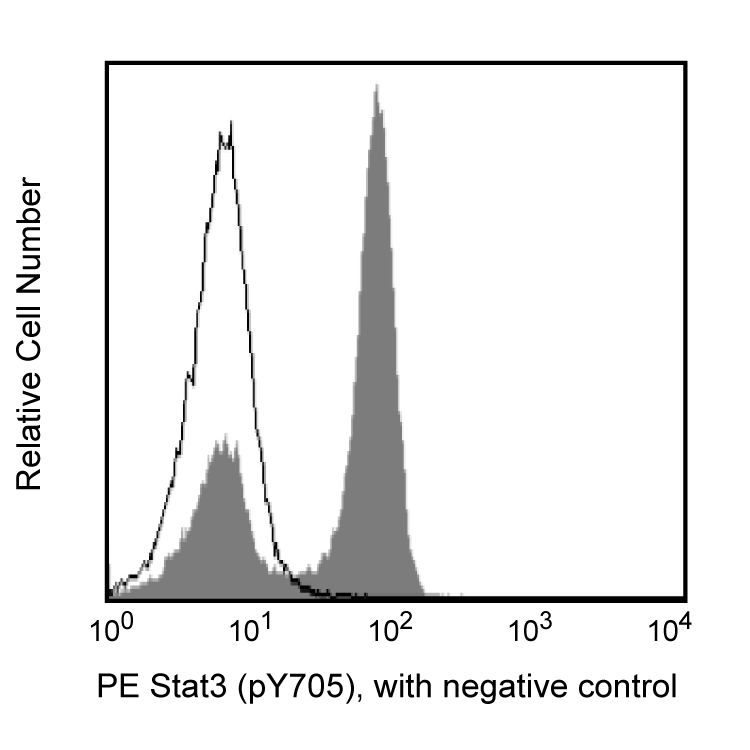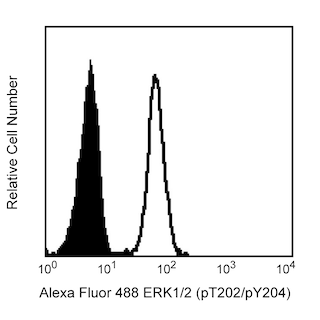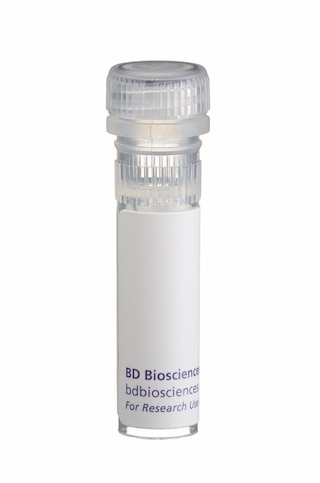Old Browser
Looks like you're visiting us from {countryName}.
Would you like to stay on the current country site or be switched to your country?


.png)

Flow cytometric analysis of Stat3 (pY705). Human whole blood was collected in the presence of heparin. Whole blood was either left unstimulated (unshaded) or stimulated (shaded) with recombinant human IL-6 (MN 550071) at 100 ng/mL for 15 min at 37 °C. Cells were lysed and fixed in a single step using BD Phosflow™ Lyse/Fix buffer (MN 558049) for 10 min at 37 °C. Cells were then permeabilized in BD Phosflow™ Perm Buffer III (MN 558050) for 30 min on ice or overnight at -20 °C. Cells were then washed twice in BD Pharmingen™ Stain Buffer (MN 554656) and stained with PE mouse anti-Stat3 (pY705) antibody for 30 min at room temperature. Samples were analyzed on a BD FACSCalibur™ instrument.
.png)

BD™ Phosflow PE Mouse Anti-Stat3 (pY705)
.png)
Regulatory Status Legend
Any use of products other than the permitted use without the express written authorization of Becton, Dickinson and Company is strictly prohibited.
Preparation And Storage
Product Notices
- This reagent has been pre-diluted for use at the recommended Volume per Test. We typically use 1 × 10^6 cells in a 100-µl experimental sample (a test).
- Source of all serum proteins is from USDA inspected abattoirs located in the United States.
- Caution: Sodium azide yields highly toxic hydrazoic acid under acidic conditions. Dilute azide compounds in running water before discarding to avoid accumulation of potentially explosive deposits in plumbing.
- For fluorochrome spectra and suitable instrument settings, please refer to our Multicolor Flow Cytometry web page at www.bdbiosciences.com/colors.
- Please refer to www.bdbiosciences.com/us/s/resources for technical protocols.
Companion Products



.png?imwidth=320)

Stat (Signal transducer and activators of transcription) proteins are critical mediators of the biologic activity of cytokines, including interleukins, interferons, erythropoietin, and growth factors. Ligand-receptor interaction leads to activation of constitutively associated JAK family kinases and subsequent recruitment/activation of Stat proteins by tyrosine phosphorylation. Active Stat proteins then move to the nucleus to promote transcription of cytokine-inducible genes. Seven Stat proteins have been cloned, each of which is differentially expressed and/or activated in a cytokine-specific and cell type-specific manner. Stat3 is a 92-kDa protein that is activated as a DNA- binding protein through cytokines, such as IL-6, and growth factors, such as EGF. Stat3 activation occurs via tyrosine phosphorylation at Y705. Tyrosine phosphorylation in response to cytokine stimulation is generally mediated by JAK1. Upon activation, Stat3 dimerizes, translocates to the nucleus and binds DNA response elements, thereby regulating gene expression. It has been reported that Stat3 binds to DNA as a homodimer, but it is also capable of binding as a heterodimer with Stat1. In addition to tyrosine phosphorylation, Stat3 is also phosphorylated at S727 via the MAPK pathway. Stat3 is widely expressed and can bind to the sis-inducible element (SIE) site from the c-fos promoter. This site is similar to the GAS element that is present in IFN-γ induced genes. Thus, phosphorylation of Y705 in Stat3 occurs in response to growth factors and cytokines, and is essential for normal transcription activity.
The 4/P-STAT3 monoclonal antibody recognizes the phosphorylated Y705 of Stat3.

Development References (3)
-
Bromberg J, Darnell JE. The role of STATs in transcriptional control and their impact on cellular function. Oncogene. 2000; 19(21):2468-2473. (Biology). View Reference
-
Imada K, Leonard WJ. The Jak-STAT pathway. Mol Immunol. 2000; 37:1-11. (Biology). View Reference
-
Liu KD, Gaffen SL, Goldsmith MA. JAK/STAT signaling by cytokine receptors. Curr Opin Immunol. 1998; 10(3):271-278. (Biology). View Reference
Please refer to Support Documents for Quality Certificates
Global - Refer to manufacturer's instructions for use and related User Manuals and Technical data sheets before using this products as described
Comparisons, where applicable, are made against older BD Technology, manual methods or are general performance claims. Comparisons are not made against non-BD technologies, unless otherwise noted.
For Research Use Only. Not for use in diagnostic or therapeutic procedures.
Report a Site Issue
This form is intended to help us improve our website experience. For other support, please visit our Contact Us page.